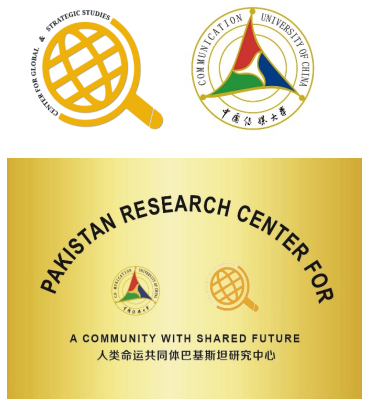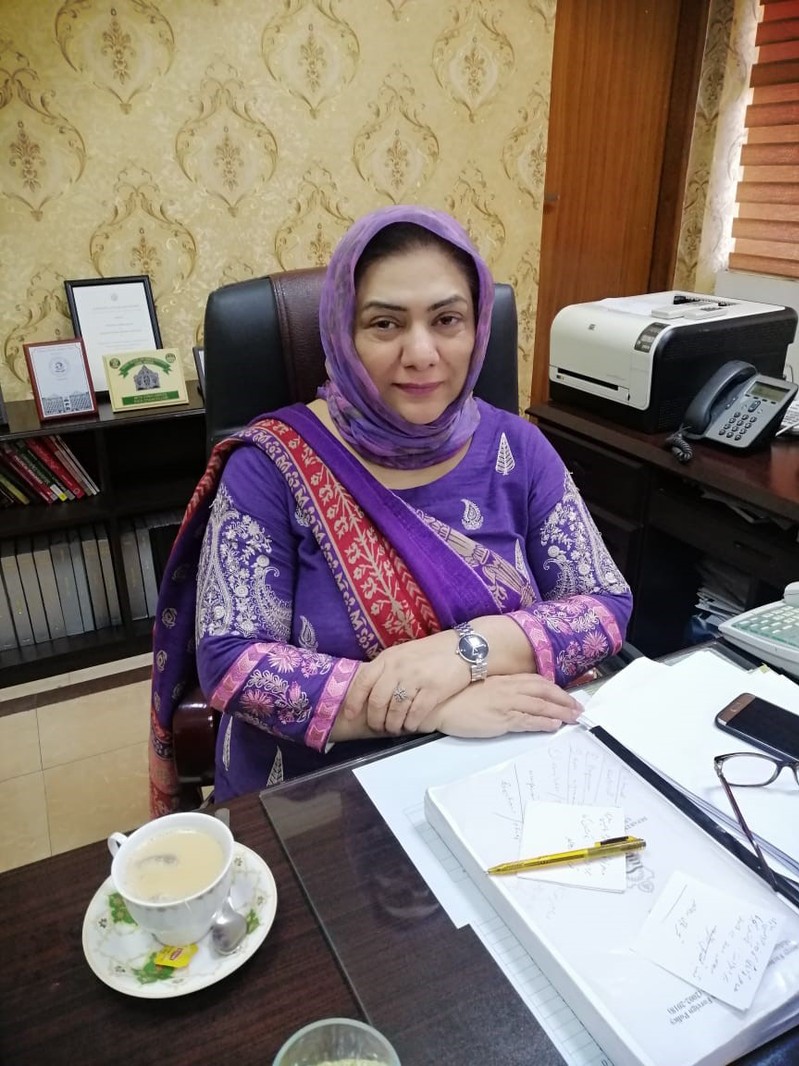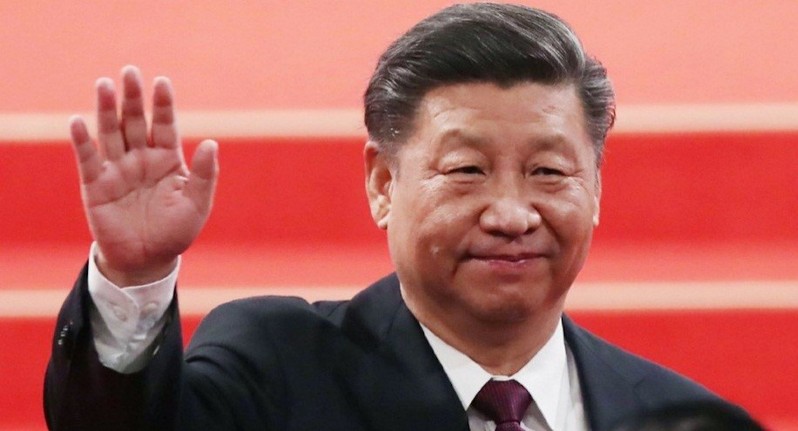

|
By Prof.Dr.Iram Khalid, Chairperson, Department of Political Science & International Relations,
University of the Punjab, Lahore
& Program Head, Dialogue of Civilization, Pakistan Research Center for a Community with Shared Future,
Communication University of China, Beijing, China
Introduction

Regardless of how it is defined, leadership is the practice by which a leader encourages or influences his peopleto achieve a shared vision. Under this conceptualization, rather than being a set of personal attributes or characteristics, leadership is an art in which leaders motivate the public to achieve certain goals (Lang, 2016). This implies that leadership andinfluence go hand in hand. So, just because someone is entrusted witha leadership role or has an official title does not mean he/she isa true leader if they do not have control over the audience. In this sense, power is strongly associated with leadership. A true leader in a political system must be capable ofwieldingpersonal power as well as position influence over others in order to inspire others to follow and propel the political process forward. Moreover, although leadership is directly tied to management andadministration, it cannot be equated with it. The distinguishing feature between the two is that while efficient management focuses on problem-solving and process control, leadership focuses on three aspects:
lGenerating a vision, giving adirection, and developing strategies.
lInspiring and motivating the public and conveying goals.
lFormingalliances and teamsto achieve shared objectives.
By applying these parameters to the study of leadership, one can certainly discern who the role models are throughout history (Hu, 2019).
Model Leadership: Theoretical Framework
Attributes of a good leader have been studied thoroughly over the past years. According to the studies,good leadership attributes do not necessarily lead to successful leadership (Ahmed and Bach 2014). A study stated that as modern organizations are dynamic, so contemporary leaders are forced to adopt new leadership skills for improving productivity (Burke 2007). Important attributes of a good leader include the ability to make an important decision, have good listening skills, and lead without any supervision.For an individual to become a successful leader purity of intent and impartiality of decisions are important (Anderson 2015). However, various studies from the early 20th century have tried to find and highlight qualities of a good leader and in doing so various theories on leadership have been put forward.Leadership theories are classified by Northouse (Northouse 2021)andHofmann and Morgeson (Hofmann 2004) into behavioral theory, power or influence theory, trait theory, and contingency theory. Before the 1970s, crucial leadership theories included contingency, behavioral and trait theories. Trait theories, also known as “great man theory”, were focused on personality traits of good leaders which distinguished them from others. For instance, according to Naoum(Naoum 2011) traits associated with good leaders include integrity, likability, good decision-making ability, assertiveness, and empathy. While according to Northouse (Northouse 2011), honesty, the will to lead, and knowledge about the job are traits of a good leader. Because of these different opinions, behavioral theories came forward. Behavioral theories were focused on what leadership behavior should be present in a good leader. So, opposed to trait theories, it was focused on the behavior and actions of a leader. In the early 1950s,Ohio State University (OSU) and Michigan University (MU) organized an investigation in which leadership behaviors associated with behavior theory were revealed, these included initiation and consideration (Naoum 2011). The result of the investigation showed that sympathetic leadership behavior is based on building good relations and two-way communication, developing good behavior towards juniors, and being attentive. While initiating leadership quality is based on allocating tasks, planning, and communicating.Blake and Mouton presented Managerial Grid, which is the best known managerial behavior model (Northouse 2011). In this model leadership behavior associated with effective management was given. It concreted on two leadership behavior including task-orientated and people-orientated behavior. Task-orientated behavior is related to production while people-orientated behavior is related to ensuring a productive working environment and developing trust. Therefore, it can be said that for achieving organizational goals diversity in leadership behavior according to different circumstances and situations is required. Contingency theories are focused on understanding the situations where the behavior of leaders will be functional (Northouse 2011).The basic idea of this theory is that the efficiency of the leader is situation-specific (Yukl and Mahsud 2010). Contingency theory is based on the idea that superlative leadership behavior does not exist, and the ideal leader behaves according to the conditions and contexts. Hofman and Morgeson stated that transactional and transformational leadership can be considered behavioral leadership styles (Hofmann 2004).

Transformational/transactional leadership (discussed in detail in the next section) is focused on the supremacy of leaders over the actions of subordinates for integrating strategies and aims of the organizations. Burns was the first one to mention transformational leadership in the political literature (McCleskey 2014). It was described as the ability of a leader to encourage subordinates for meeting collective goals irrespective of their motives (Burns 2003). According to Flin and Yule (Flin and Yule 2004) and Yulk (Yukl and Mahsud 2010), transformational leaders are those who act as mentors and ideals and motivate subordinates. This enables workers to think flexibly and bring creative innovation to the organization.Another study on transformational leadership and the performance of employees showed that such leadership has many benefits including higher productivity, less absenteeism, and ensuring a peaceful and safe work environment (Inness, Turner et al., 2010). While Northouse defined transactional leaders as those who anxiously inspire employees to meet organizational goals achieve performance benchmarks, and compensate them in return (Northouse 2021). Such leaders do not worry much about individual employee needs as opposed to transformational leaders.
On the whole, leadership can be defined as the impact of an individual over the group of subordinates for accomplishing organizational or individual aims (Benscoter and Rothwell 2012). Characteristics of a leader that determine the success of the organization are stated by Muteswa as “the qualities of a good leader, the difference of a boss and a leader, emotional intelligence, objectives of leadership and the advantages of good leadership”(Muteswa 2016). Crucial leadership characteristics and attributes were explored by Shah and Pathak among the young students (Shah and Pathak 2015). The study contained students from Mumbai and a list of forty-seven qualities were given to them. They were asked to highlight any five characteristics they note before opting for the class leader. The results showed that the most crucial attributes of a leader included honesty and confidence. The interpersonal abilities of leaders and their impact on various tiers of management were studied by Khan and Ahmad (Khan and Ahmad 2012).The study included different departments of Kohat University of Science and technology. The results showed that at the top level of management team building ability is most important while at lower levels motivational skill is important. Literature on qualities of good leadership is scarce, despite its importance in improving the efficacy and productivity of the organization.
Qualities of Modern Leader based on Leadership Theories
It is clear that leadership and organizations of the 21st century are different. They face different challenges in a new world. Thus, the social abilities of leaders are under focus, not their behavior and attributes. On the basis of different leadership theories, trait theory focuses on the innate qualities of a person that help him to lead through his entire life. Such individuals are called born leaders as they have the quality to lead others (Zaccaro, Dubrow et al. 2018). Such leaders have extrovert personalities, intellectual skills, self-efficacy, and are open to experience. While the behavioral theory is focused on behavior rather than the innate traits of the leaders. According to this, leadership can be learned with age. This theory analyzed the behaviors of the great leaders comprehended their strategies in particular circumstances, which showed their leadership behavior(Yukl and Mahsud 2010). On the other hand, according to the contingency theory, strategies of leaders are modified according to the need of the situation. The external and internal situations of the organization determine the role of the leader(Fiedler 2015).
On the whole, organizations of the 21st century are different and more complex from the previous century, regarding communication and IT, absolute dependency on contemporary information sources, and distant boundaries. The general means of communication have changed which has led to changes in the ways individuals relate to each other. Presently, how people communicate with one another and change their skills and career is the center of attention. For achieving success in the modern world acquiring knowledge and important skills like media knowledge, information literacy, and learning communication patterns is very important. Many qualities are required for becoming a good leader:
Ability to Provide Integrity and Moral Support
Challenges of the current century require strong leadership that leads the team in difficult circumstances. Modern times demands that leaders should coordinate with the team both morally and physically, rather than just directing them.
Being Present
Modern challenges require that leaders should be available at every time. The leader should always be available for employees, but should not interfere in their tasks.
Exhibit Creative Thinking
Managing time and taking time out for thinking out of the box for future plans and goals are required from the leaders of modern times.
Thorough Knowledge and Interest in Job
The 21st century encourages people to be open to learning more. A leader should possess the desire to learn new skills with time. Good leaders think long-term while putting efforts into achieving organizational goals.
Managing Skills
A good leader has management ability that results in an organized set up and has the ability to address the concerns and needs of all the employees. Decision-making and problem-solving abilities are also part of management. Good leaders empower their subordinates and manage their systems. The economy and organizations of the 21st century require skillful leaders who are able to take effective and quick decisions.
Effective Communication
An important quality of a good leader is communication skills, using which he should spread his knowledge. They should demonstrate the power to negotiate and clarity in communication through their conversation. This will give alignment directly to the team and enable them to follow their leader. Good communication is key to successful leadership. Good leaders effectively communicate their plans and objectives with their employees.
It is clear that the 21st century needs completely new qualities in a leader. The new model of leadership contains crucial characteristics required in a leader in the light of leadership theories.The problems of the present times are so different that modern leaders will not be able to solve them if follow old self-interested and authoritarian leadership practices (Powers 1992). Such leadership practices have created problems in past and they require modern solutions.
Comparing the Leadership Theories: Transformational vs Transactional
Good leadership, inNye's (2013)opinion, needs both vision and execution. Based on this he differentiated presidential leadership into two types: transactional leadership and transformational leadership. Transactional leaders, are more concerned with planning and implementation and rely on an ‘incentive-based approach’ to attract the self-interest of people. Transformational leaders, on the other hand, have a fresh vision for the country, are able to appeal to their followers' higher principles and moral standards, and encourage them to do adaptive work and acknowledge thechange (Hu, 2019).
The core principles of both leadership theories are unique in how leaders drive their followers (Woods, 2019). The empowering of supporters instead of the enforcement of control methods and sanctions is one of the core features of the transformational style.Yukl (2008) asserts that since transformational leadership style believes in empowering people. These leaders put the sharedgoals ahead of their own. The fundamental goal of the transformational approach is bringing a major change through the establishment of new ideals and the exploration of new solutions to the existing issues (Groves & LaRocca, 2011). Thus, as opposed to conformity,performance, and consequence, which are features of transactional leadership, follower reaction is based on participation and dedication. Furthermore, followers and leaders, per this theoretical perspective, function and interact as a system, expanding and elevating the status quo of ethics and moral desire (Burns, 1978). This is in stark contrast to the transactional approach, which calls for extensive controland monitoring and finds it not only necessary but also appropriate. McCleskey (2014) noted (p.6)A central tenet of transactional leadership theory is the focus on social and economic exchanges between the follower and the leader. As a result, contingent incentives appealing to the public's self-interest, as well as leadership's behaviors geared to sustain beneficial conduct, are the only sources of motivation. Follower commitment, in accordance withtransactionaltheorists, is temporary, and connections are continually redefined (Groves & LaRocca, 2011).
According to Burns (1978), the essential distinction between both styles is founded in what these theories preach that people and leaders provide each other, and with transactional leadership, contact is created to promote an exchange of value. The parties are aware of the resulting relationships, yet they continue to pursue their separate goals, which are not bound by the same shared goal. Transformational theorists, on the other hand, contendthat a leader's engagement with followers determines the levels of morality and motivation. As it serves a common goal, the power source within this paradigm enhances the degree of human behavior and morality of both the followers as well as the leader (Burns, 1978).
One of the key tenets of the transformational style is its commitment to social mores and the promotion of human partnership above individual activity and continuous conflict. According to Keskes (2014), transformational leaders followmore of an ongoing process than transactional leaders, which is characterized by unique exchanges. Burns (1978) also distinguished between both leadership styles, claiming that they are polar opposites. He proposed that both styles are essentially unrelated and that a leader may exhibit either of the two, but not both.
Hay (2007) further claimed that the transactionaldimension is strongly rooted in teleological concepts endorsing behavior on a contingency basis and is entrenched in an atomistic viewpoint marked by altruistic goals. Groves and LaRocca (2011) claim that teleological emphasis concentrates on ends and outcomes, which is consistent with transactional leader's influence process. The transformational dimension, on the other hand, is discovered to be based on “deontological principles”, where obligation andresponsibilityfor moral validation serve as the foundation for guiding behavior (Groves &LaRocca, 2011).

Xi Jinping as a Role Model in the 21st Century:
Xi Jinping, the Chinese president, and a great leader is a historical figure who is slingshotting China onto the global stage. (Hong, 2016). When compared to his predecessor, Hu Jintao, Xi Jinping matches all of the characteristics of transformational leadership. His transformative approach can be attributed to a number of reasons.First, being a member of the Red Second Generationor offspring of China's revolutionary leaders he ownsa much strong sense of historical responsibility for the country as well as the party.He constantly reminds everyonethat we must never forget why we started and our noble goal of revitalizing China. He believes he has a historical calling or a quest to accomplish something in a short period of time while in government (Hu, 2019).
Second, unlike his predecessors, he is quite ambitious and risk-tolerant. Xi is willing to take chances in order to achieve his objectives. He maintains that China as well as the rest of the globe are undergoing significant and complex transformations and China is still in a critical time of strategic development opportunity. Moreover, the country's strategic potential should not be built on the faults of others; instead, China should take charge andgenerate development opportunities. Thus, he urges the people to aim high and look far,”as well as to have the courage to pursue reform and break new ground, and never become hardened to change or inactive.[1] (Cabestan, 2019).
Lastly, he is capable of articulating a strong vision for the country and for himself. Since assuming powerin 2012, he effortlesslyexpressedhis vision to thepeople in an extremely simplified way. He describes his vision with phrases like China Dream and centennial goals. He reaffirmed his ambition of constructing a modern China by 2035 and growing China into a great modern socialist country by the mid-21stcentury. We are closer, more confident, and more capable than ever before of making the goalof national rejuvenation a reality,he asserted at CCP 19th Congress (Hu, 2019). Xi Jinping's strong “sense of responsibility”in foreign policyalso has aidedhim to be more transformational in reshaping Chinese diplomacy. On foreign policy concerns, he has demonstrated a considerably larger and broader frame of vision. He positions China as part of a larger objectiveof creating a community with a shared future for mankind and forging a new pattern of strategic tiesbased onfairness, mutual respect, equity, and win-win partnership (Hu, 2019)
When Xi gained power in 2012, China was undergoinga considerably more difficult and complex situation than under his predecessorHu Jintao. Since then, China's foreign policy has faced numerous obstacles, both external and domestic, global and regional. His Excellency Xi Jinping efficientlypushed Chinese foreign policy away from the policy of keeping a low profile. He adopted an assertive strategy towards China's foreign policy leading to drastic changes inChinese diplomacy. Xi carefullyraised the degree of activism, broadened the size of contact, set new targets, and infused innovative thinking in handlinginternational affairs (Zhang, 2019)
Calm, rational, firm yet gentle, Xi has his own set of principles. Since for China, regional issues have historicallybeen a major challenge and primary concern. Xi adopted anapproachto foster good neighborliness without jeopardizing China's national interests (Hu, 2019).Even with his North Korean ally, who once breached China's national interests, he firmly constituted sanctions (Hong, 2016). His diplomaticpolicy sends a strong message tothe world that China will not pursue development at the cost of others' objectives, butno one should expect China to ever relinquish its rightfulinterests. Xi's message is more direct and stronger than that of his forerunners. Xi demonstrated a greater willingness and ability to protect China's basic national interests.
Not just in China, but Xi emerged as an increasingly influential leader in the global scenario. By elaborating on the meaning of the China dream and its worldwide ramifications, he contendedthat China's development, rejuvenation, and nation's well-being are inextricably intertwined with the national aspirations of people all across the globe. What makes Xi a role model is his vision that the “China dream” cannot be realized without a stable global setting and a robust international system. Xi Jinping offered the concept of a community of a shared future for mankind for the first time during the Boao Forum's annual gathering in 2015. He stressedthat humankind has only one planet, that all states are situated on it, soour fate is intertwined. Thus, not separately or individually, but together, all nations on the earthmust thrive (Hu, 2019).
He is also referred to as the new geopolitical master. His One Belt, One Road plan is expected to haveconsiderably greater influence in changing the globaldynamics as compared tothe Marshall Plan(Hong, 2016). B&R's project immensely speaksof Xi'sinnovative leadership and long-term planning. It is inspirationalin that it promotes political communication, infrastructure connectivity, trade liberalization, capital free movement, and people-to-people dialoguesfor more than 50 states across its path (Hayes, 2020).
In summary, some of the key aspects that make Xi Jinping a model in the 21st century are as follows:
Small-Circle Decision-Making
President Xi quickly consolidated his influence after assuming power and grew to become a single dominant figure. He changed the party's collective leadership philosophy, which was established by Deng Xiaoping and other senior officials, who agreed to never allow aleader to wield such power alone (Shan, 2016). In Xi’s case, it is believed that he makes major judgments without consulting a lot of people (Shan, 2016)
Strong-Willed yet Flexible
As a president, Xi has proven to be an assertive and unrelenting leader. When it comes to cracking down on political enemies and dissidents at home, Xi is harder and more ruthless than his forerunners. Since Deng, there has been an unspoken precedent that criminal charges will not be brought against members of the Politburo Standing Committeeor key military officials. This norm has been significantly reversed as a result of his anti-corruption drive. In a similar vein, Xi ismore forceful in foreign affairs. Although in his state visits to foreign countries, his casual speech and charm demonstrate soft power (Hong, 2016), his personal leadership style is said to dominate international policymaking (Shan, 2016).
Populism
Populism is a strategy used by political leaders to cement their power base by offering regular people what they desire. In this endeavor, Xi has been victorious (Babones, 2017). It is quite evident that Xi has been able to centralize power and push through his anti-corruption drive, as well as reforms to the People's Liberation Army and other reforms, primarily due to public support. According to apublic opinion poll conducted by a Harvard University research center, when26 thousandindividuals from 30 nations were asked to rank 10 world leaders, Chinese participants rated Xi higher than any other ruler rated by hisown people.“ Chinese respondents showed the highest confidence in regard to how their leader handled domestic and international affairs”. This success was not achieved by chance. Xi is the first Chinese president to have a large team dedicated to raising his public presence. The party's propaganda machine has been activated to promote Xi in a massive manner. It won't be wrong to say that he is the poster boy on billboards across roadways and in eateries, images in papers and on the internet, and even tiny trinkets sold by street sellers. Thus, one can safely say that Xi has efficiently adopted the new-age strategies to reach the masses and earn their trust (Shan, 2016)
Conclusion
Leadership is described as a crucial skill that enables an individual to work in a team for the fulfillment of the goal. In a constantly evolving world, leaders must behave differently and acquire knowledge for strengthening organizational setup. For success in the 21st century, leaders are required to improve communication and motivate their employees. The leaders who empower their employees, develop creative skills, and critical thinking among them create a successful organizational system. It is a fact that leaders of the 21st century must act and think more efficiently than leaders of the previous century. By acquiring true leadership qualities, leaders play important role in the success of the whole team. A good leader has a positive attitude and makes correct decisions through his positive behavior. The idea of leadership in the 21st century revolves around responding to opportunities and challenges of the modern world. It reflects an extensive leadership paradigm and is based upon practices and theories that foster transformative change for a better world.
References
Ahmed, A. D. and C. Bach (2014). Major traits/qualities of leadership. International Journal of Innovation and Scientific Research 3(1): 47-53.
Anderson, A. R. (2015). Good Leaders Are Invaluable to A Company. Bad Leaders Will Destroy It.
Babones, S. (2017). Xi Jinping: Communist China’s first populist president.
Benscoter, G. M. and W. J. Rothwell (2012). The Encyclopedia of Human Resource Management: Thematic Essays. Volume Three, John Wiley & Sons.
Burke, R. B., S. (2007). Project Management Leadership.
Burns, J. M. (1978). Leadership and followership.Leadership, 18-23.
Burns, J. M. (2003). Transforming leadership: A new pursuit of happiness, Grove Press.
Cabestan, J. P. (2019). Political changes in China since the 19th CCP Congress: Xi Jinping is not weaker but more contested.East Asia,36(1), 1-21.
Groves, K. S., & LaRocca, M. A. (2011). An empirical study of leader ethical values, transformational and transactional leadership, and follower attitudes toward corporate social responsibility.Journal of business ethics,103(4), 511-528.
Fiedler, F. (2015). Contingency theory of leadership. Organizational Behavior 1: Essential Theories of Motivation and Leadership 232: 01-2015.
Flin, R. and S. Yule (2004). Leadership for safety: industrial experience. BMJ Quality & Safety 13(suppl 2): ii45-ii51.
Hay, I. (2006). Leadership of stability and leadership of volatility: Transactional and transformational leaderships compared.Academic Leadership: The Online Journal,4(4), 6.
Hayes, A. (2020). Interwoven ‘Destinies’: The significance of Xinjiang to the China dream, the belt and road initiative, and the Xi Jinping Legacy.Journal of Contemporary China,29(121), 31-45.
Hofmann, D. M., F. P. (2004). The Role of Leadership in Safety.
Hong, L. (2016). Great Power Leader Xi Jinping: International Perspectives on China's Leader. Amazon.
Hu, W. (2019). Xi Jinping’s ‘major country diplomacy’: The role of leadership in foreign policy transformation.Journal of Contemporary China,28(115), 1-14.
Inness, M., et al. (2010). Transformational leadership and employee safety performance: A within-person, between-jobs design. Journal of Occupational Health Psychology 15(3): 279.
Keskes, I. (2014). Relationship between leadership styles and dimensions of employee organizational commitment: A critical review and discussion of future directions.Intangible Capital,10(1), 26-51.
Khan, A. and W. Ahmad (2012). Leader's interpersonal skills and its effectiveness at different levels of management. International Journal of business and social science 3(4).
Lang, R. (2016). Peter G. Northouse: Leadership-Theory and Practice (7th Edition).Organization Studies,20(2), 354-354.
McCleskey, J. A. (2014). Situational, transformational, and transactional leadership and leadership development. Journal of business studies quarterly, 5(4): 117.
Muteswa, R. (2016). Qualities of a good leader and the benefits of good leadership to an organization: A conceptual study. European Journal of Business and Management 8(24): 135-140.
Naoum, S. (2011). People and Organisational Management in Construction.
Northouse, P. G. (2011). Leadership: Theory and Practice.
Northouse, P. G. (2021). Leadership: Theory and practice, Sage publications.
Nye, J. S. (2013).Presidential leadership and the creation of the American era. Princeton University Press.
Powers, P. J. (1992). Toffler's Powershift: Creating New Knowledge Bases in Higher Education.
Shah, S. and K. Pathak (2015). Exploring Important Leadership qualities and characteristics among adolescent students. IOSR Journal of Humanities and Social Science (IOSR-JHSS) 20(9): 46-52.
Shan, W. (2016). Xi Jinping’s Leadership Style.East Asian Policy,8(03), 42-53.
Woods, T. B. (2019). An examination of the suitability of transactional, transformational and situational leadership theories in evaluating the role of gender in determining the leadership style: A comparison and contrast of three leadership theories.American Journal of Management Studies,4(1), 1-11.
Yukl, G. (2008). How leaders influence organizational effectiveness.The leadership quarterly,19(6), 708-722.
Yukl, G. and R. Mahsud (2010). Why flexible and adaptive leadership is essential. Consulting Psychology Journal: practice and research62(2): 81.
Zaccaro, S. J., et al. (2018). Leader traits and attributes.
Zhang, F. (2019). The Xi Jinping doctrine of China's international relations.asia policy,26(3), 7-23.
Edited by the Institute for a Community with Shared Future, CUC
To view, kindly visit the following links:
